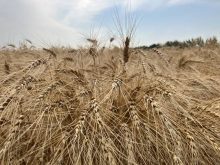A major influence on global weather and climate is the La Nina and El Nino cycles, which involve warming of the waters in the central and eastern Pacific Ocean. The changing ocean temperatures influence cloud formation and precipitation patterns.
The El Nino phase describes warming, while the La Nina cooling in a similar area. In between the two phases there is a neutral phase. It can last only a couple of months or it may take close to four years to enter the opposite phase.
“All indications are for neutral conditions to persist until spring 2014.” said David Phillips, senior climatologist with Environment Canada. The challenge about neutral conditions is that long-term weather forecasts, which are already challenging to predict with accuracy, become even more difficult.
Read Also

Record large Canadian wheat and canola crops: Statistics Canada
Canadian wheat and canola production in 2025/26 (Aug/Jul) surpassed early expectations to hit new record highs, according to updated survey-based estimates from Statistics Canada released Dec. 4.
“Of the 20 winters with neutral conditions since 1950, six were warmer than normal, six were colder and eight were average. There are no revealing patterns from a neutral phase,” Phillips said.
His observations are supported by others. On Aug 27, the Climate Prediction Center of the U.S. National Oceanic Atmospheric Administration, alongside the Australian Bureau of Meteorology, released their forecast for El Nino/La Nina cycles. All but one of the international climate models suggest neutral conditions. The one model shows only a small chance of a brief period of La Nina in the spring before returning to neutral conditions. There are no models showing a strong phase beginning in the short-term future.
There has been some speculation by a few U.S. agricultural analysts that La Nina would provide additional support for North American oilseed values. Over the past week, Chicago soybean futures markets have seen substantial volatility. On Aug. 27 the November 2013 soy future closed above $14, when it had been below $12 at the start of the month. Persistent dryness in the western Corn Belt, especially in the No. 1 soy-producing state of Iowa and No. 3 producing Minnesota, raised concerns.
The yield potential for soybean is still vulnerable and anxieties are growing that the abundant production forecasts may not be achieved. The recent rise in soybean futures values buoyed the entire oilseed complex.
The impact of Brazilian, Argentinian and Paraguayan soybean production on North American markets cannot be understated. Together the three countries account for more than half of the world soybean production, the majority of which is exported. On Aug. 26 Brazilian consulting firm Agroconsult forecast soybean area will grow to a record 29.3 million hectares, compared to 27.7 million in the previous year.
The U.S. Department of Agriculture is also forecasting a record area, albeit slightly smaller at 28.3 million hectares. USDA currently predicts record area in Argentina and near-record in Paraguay. The current environment sends all the signals to South American producers, who are on the cusp of their planting season, to favour soybeans over corn.
Even if soy production problems surface in the U.S., provided the South American harvest is as large as currently predicted canola and soybean value will be challenged to maintain high prices.
If midwinter weather scares build in the south, additional price rallies may be in store. La Nina typically brings hot and dry condition to the South American growing area with predictable yield declines. The 2008-09 and 2011-12 growing seasons were most recent strong La Nina events, where soybean production dropped significantly.
— Stuart McMillan writes from Winnipeg on weather and agronomic issues affecting Prairie farmers.














